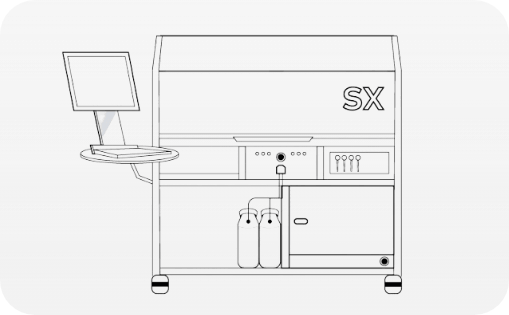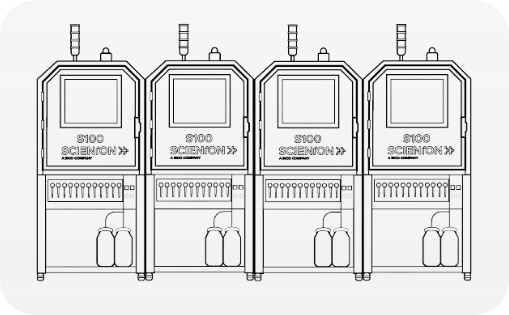Microarrays and Biosensors
Precision Dispensing for Next Generation Multiplex Assays
Microarrays and biosensors are two cornerstone technologies in modern diagnostics and life sciences, enabling the simultaneous detection of multiple biological targets from a single, minimal-volume sample. Microarrays are structured matrices of immobilized biomolecules (DNA, RNA, proteins, or antibodies) that capture and analyze specific analytes in parallel. They are used for applications such as biomarker discovery, disease diagnostics, drug response profiling, and personalized medicine. Biosensors, on the other hand, convert biological recognition events into measurable physical or chemical signals. They take many forms, electrochemical, optical, or mass-sensitive, and are increasingly used in point-of-care diagnostics, environmental testing, and real-time health monitoring.
Despite their different output principles, both technologies share common challenges:
- achieving precise, uniform deposition of biological reagents,
- maintaining spot or coating consistency across thousands of features,
- ensuring contamination-free handling and reproducible performance across batches,
- and balancing scalability with traceability and compliance for regulated markets.
At the heart of these processes lies one critical factor: control at the picoliter scale. Reliable, contact-free dispensing is essential to ensure consistent signal output, reduced waste, and accelerated assay development.
That’s where SCIENION’s sciFLEXARRAYER® platform comes in. Built for applications that demand the highest precision and reproducibility, our non-contact piezo dispensing systems enable exact and contamination-free deposition of biological materials on any substrate, from glass slides and membranes to silicon photonic chips and polymer sensors. Whether you’re developing R&D assays or scaling up manufacturing, SCIENION delivers the accuracy, consistency, and throughput required to advance microarray and biosensor technologies from concept to commercial success.
Trusted by






MICROARRAYS AND BIOSENSORS APPLICATIONS

Clinical & Personalized Diagnostics
SCIENION’s non-contact microdispensing accuracy enables multiplex assays for biomarker discovery, antibody detection, allergy diagnostics or genetic profiling.
Environmental & Food Safety Monitoring
sciFLEXARRAYER systems ensure precise, contamination-free dispensing for assays detecting antibiotics, pesticides, VOCs, and waterborne contaminants.

Next-Gen Chip-Based Sensors
SCIENION’s precision microdispensing technology supports advanced biosensor formats such as silicon photonic, microcantilever, and microfluidic chips.
Redefining Precision for the Diagnostics of Tomorrow.
sciFLEXARRAYER instruments combine piezo-driven non-contact dispensing with advanced vision control for unmatched reproducibility. Whether printing proteins, DNA, or nanoparticles, SCIENION’s platforms guarantee precision and reliability across formats—empowering research, diagnostics, and biosensor production at any scale.
Featured Resources

PUBLICATION
Precision Microarrays Unveil New Blood Group Tools
Led by Dr. Richard D. Cummings, a global pioneer in glycoscience and Director of Harvard Medical School’s National Center for Functional Glycomics (NCFG), this multi-institute team created novel lamprey VLR antibodies to human blood group carbohydrates. Using the sciFLEXARRAYER SX in the NCFG’s state-of-the-art facility, they printed custom glycan microarrays with >70 antigens, enabling high-throughput antibody profiling and setting new benchmarks for anti-glycan reagent discovery. This work empowers diagnostics, transfusion medicine, and fundamental glycobiology worldwide.

Video
Water Quality Analysis with Universal Pathogen Arrays
As part of the EU-funded microAQUA project, SCIENION’s non-contact microdispensing technologies enabled fabrication of multiplex microarrays capable of identifying up to 150 pathogens across fresh, marine, and drinking water. The system’s high precision and reliability make large-scale environmental monitoring fast, quantitative, and reproducible, supporting public health and sustainability initiatives.

PUBLICATION
Empowering Hemophilia Diagnostics, sciFLEXARRAYER at the Heart of Innovation
Developed by Enzyre B.V., a pioneering Radboud University Medical Center spin-off recognized for its groundbreaking point-of-care biosensor technology, this microfluidic device enables sensitive, real-time factor VIII measurement for hemophilia A patients. The team, led by Dr. Waander van Heerde, used the sciFLEXARRAYER S3 for nanoliter reagent deposition, enabling robust, reproducible chemiluminescence assays in integrated microfluidics. This collaboration advances patient-centric care and sets new benchmarks in clinical biosensor development.

APPLICATION NOTE
Making Spatial Transcriptomics Accessible with Microdispensing
Spatially resolved transcriptomics enables scientists to measure all gene activity in a tissue sample and map where the activity is occurring. Traditional methods have been limited by high costs, restricting access to only a few labs. Using SCIENION’s sciFLEXARRAYER S3 precision microdispenser, we support a low-cost strategy to manufacture double-barcoded DNA arrays. This approach has already been successfully applied to large-scale studies of human brain organoids, creating detailed three-dimensional maps of complex tissues.

VIDEO
sciFLEXARRAYER S3 Powers Next-Gen Microcantilever Biosensors
At Madrid’s IMN-CSIC, Dr. Montserrat Calleja and Dr. Javier Tamayo’s Bionanomechanics Lab, front-runners in nanomechanical sensor innovation, partnered with Mecwins S.L., a high-tech company commercializing ultra-sensitive label-free biosensors and holding key patents from this research. Using the sciFLEXARRAYER S3 for software-guided, non-contact DNA and protein spotting onto gold microcantilevers, the team enables robust, multiplexed biochip production for applications from tuberculosis to cancer. sciFLEXARRAYER’s flexibility, speed, and gentle dispensing make it the ideal platform for functionalizing fragile cantilever arrays at scale.





